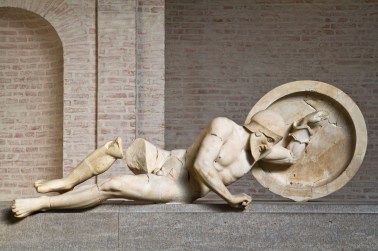Initially it must have been a nasty surprise. On 16 August 1972 an amateur scuba diver named Stefano Mariottini was fishing in shallow waters just off the coast of Calabria. At about noon he was poking around some rocks when he saw part of an arm protruding from the sand. His first thought, a natural one, was that he had found a cadaver.
On closer examination, it became clear that there was not just one body but two — and that they were made not of flesh but of metal. Mariottini’s discoveries are world-famous now, taking their name — the Riace bronzes — from the little resort near which he was swimming. In terms of classical sculpture, he had hit the jackpot.
Bronze was the medium of choice for many of the most admired artists of the ancient world. But because it is also a useful material, which is easily melted and recycled, classical bronzes have — with extraordinarily rare exceptions — totally vanished. Furthermore, the works Mariottini had chanced upon were of self-evidently high quality and by and large in excellent condition. They seem to hold out a tantalising promise: a glimpse of what ancient Greek art at the highest level was truly like.
Not surprisingly — given that the only evidence is what can be deduced from the statues themselves and the place where they were found — there have been innumerable suggestions as to which sculptor (or sculptors) might have made them. They have been connected with many famous names, including Phidias, Polykleitos, Alkamenes and Myron (one difficulty being that no bronze by any of these survives for comparison). There has been a similar multiplicity of proposals for the characters from history or myth that they might represent.








Comments
Join the debate for just £1 a month
Be part of the conversation with other Spectator readers by getting your first three months for £3.
UNLOCK ACCESS Just £1 a monthAlready a subscriber? Log in